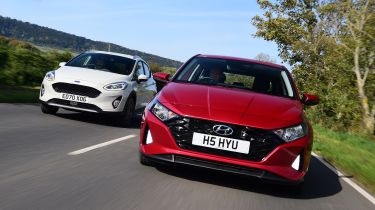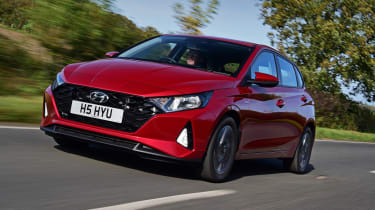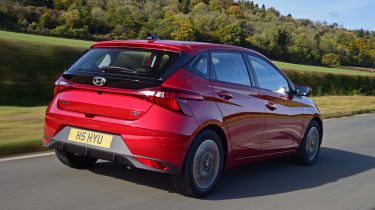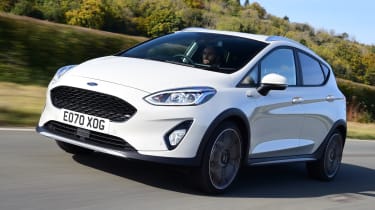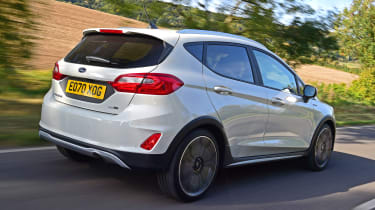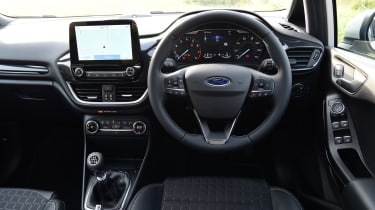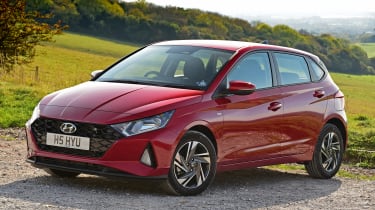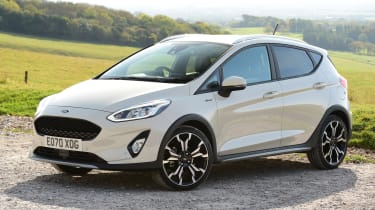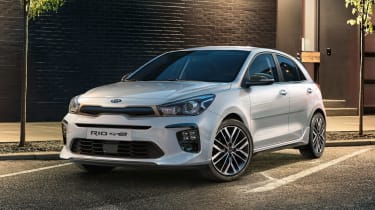Hyundai i20 vs Ford Fiesta
Two mild-hybrid superminis go head-to-head as we test new Hyundai i20 against Ford Fiesta
Despite a Covid-19-related slip in new-car registrations this year, four of the top 10 spots in the sales charts have been taken up by superminis. British buyers love these small cars because they suit our towns and cities, and fit our country lanes and driveways.
There’s clearly still life in the market then, which is why Hyundai is launching its new i20 supermini. However, even this smaller, more affordable class of car isn’t immune to the charge towards electrification. There are plenty of fully electric superminis already on sale, but conventional combustion-engined cars like the pairing we’ve got here are also having mild-hybrid tech applied to them in a bid to boost efficiency. The new i20 has 48-volt MHEV tech, which is why we’re putting it up against one of the sternest tests any supermini can face: the Ford Fiesta.
Britain’s best-seller has also been revamped under the bonnet, with a mild-hybrid system applied to its familiar 1.0-litre EcoBoost engine to help improve fuel economy.
With more tech in the i20, this promises to be a close-run contest, but both must deliver everything supermini buyers want, which stretches from usability and practicality to fun, comfort and strong fuel economy. It’s a big ask.
Hyundai i20
| Hyundai i20 1.0 T-GDi 100 Hybrid SE Connect | |
| Price: | £18,595 |
| Engine: | 1.0-litre 3cyl turbo, 99bhp |
| 0-62mph: | 10.4 seconds |
| Test economy: | 52.2mpg/11.5mpl |
| CO2: | 115g/km |
| Annual road tax: | £150 |
Hyundai means business with the new i20, because even this most affordable £18,595 1.0 T-GDi mild-hybrid SE Connect model sports a lot of technological advances. Let’s find out what they are.
Used - available now

2023 Audi
Q4 Sportback e-tron
54,526 milesAutomaticElectric
Cash £23,363
2022 Kia
Niro
18,315 milesAutomaticPetrol1.6L
Cash £17,900
2023 Nissan
Juke
40,858 milesManualPetrol1.0L
Cash £12,287
2022 Volkswagen
T-Roc
36,779 milesAutomaticPetrol1.5L
Cash £18,600Design & engineering
The car’s platform has been heavily revised, with more focus placed on driver enjoyment. It’s a hallmark of Hyundai’s R&D boss, Albert Biermann, because the German has some of BMW’s best-driving M cars on his CV.
He’s also the man who has masterminded the Korean firm’s N brand for sporty cars, with a lot of the forthcoming i20 N’s ability baked into the regular version, just as Ford has done with the Fiesta and the ST. The suspension is conventional, with MacPherson struts up front and a torsion-beam rear axle.
The big news for this regular i20 supermini is that the 1.0-litre three-cylinder turbocharged engine is supported by a 48-volt mild-hybrid system with an integrated belt-starter generator. The small lithium- ion battery (located in the well beneath the boot floor, so there’s no spare wheel) can power ancillaries such as the electric power steering, allowing the engine to switch off and coast at higher speeds to boost efficiency.
The generator charges the battery when slowing, but it can also supply a small amount of torque for a short period to help with initial acceleration.
Another interesting and new feature making its debut on the i20 is Hyundai’s six-speed intelligent Manual Transmission (iMT). There’s still a clutch pedal, but its movement is interpreted by a sensor, with an electronic linkage activating the physical clutch between the engine and transmission. It means the engine can be switched off for coasting even when theoretically in gear, because the car will decouple the clutch automatically. Ratios are still shifted manually as per a regular car.
The iMT means the car can make the most of the mild-hybrid tech, coasting either with the engine at idle or switched off completely at higher speeds. The powertrain produces 99bhp and 171Nm of torque. There’s just one choice of engine in the UK, but this is the one to go for anyway.
Driving
Hyundai has thoroughly reworked the i20’s underpinnings, because this is the best-driving version yet: actually fun behind the wheel in some situations. It’s still not quite on the Fiesta’s level, but the steering has been retuned and the suspension tweaked so that the front end is more responsive than before.
The nose is now keen to turn towards a corner’s apex. The steering is surprisingly quick, like the Ford’s, and you don’t have to use much lock, nor do you have to add much in the middle of the bend such is the i20’s improved agility and grip.
While the rear end, in particular, still hops and skips over harsh mid-corner bumps, so does the Ford’s. Yet for most of the time the i20’s chassis is smooth and controlled, offering a compliant ride with acceptable body control that nicely balances engagement, agility, comfort and composure.
It’s certainly not as firm as the Ford, but neither is it quite as controlled at a faster pace; the i20’s damping does break down a little earlier than its rival’s, but overall it’s refined on 16-inch wheels.
The same goes for the powertrain; the 1.0 T-GDi engine doesn’t grumble much, even under load. The small electrical assistance no doubt helps, and even though it’s still down on power compared with the Ford, the hit of torque low down is strong enough, while the 10.4-second 0-62mph time is adequate. The iMT’s clutch feels no different to a regular car’s. Its shift action is a little notchy, but precise enough.
Practicality
An increase in size has meant a big increase in practicality for the i20. It’s five-door only, so access to the rear seats is easy, and there’s as much headroom in the rear of the Korean supermini as there is in the Fiesta. There’s slightly more legroom in the i20, however.
The Hyundai’s big advantage comes in the boot, where the capacity is 352 litres compared with just 292 litres in the Ford. It’s obviously the more practical car, even though storage is roughly equal, but the i20 also gets rear parking sensors as standard, whereas they’re a £400 option on the Fiesta. They’re clearly not necessary given the size of these cars – and visibility is good in both – but it’s nice to have them.
Ownership
A five-year, unlimited-mileage warranty and five years’ roadside assistance are big draws for the i20. Despite this, Hyundai still only finished mid-table in our Driver Power 2020 poll, taking 13th spot. Yet this was still way ahead of Ford’s 24th place. Hyundai’s cars were praised for infotainment particularly.
Safety is also a strong point with the newcomer, because it features autonomous emergency braking, along with lane-keep assist and lane-departure warning as standard, even in basic SE Connect trim. The latest i20 has yet to be tested by Euro NCAP.
Running costs
The 48-volt tech clearly benefits efficiency, with the i20 returning 52.2mpg on test, which means an annual fuel bill of £1,202 over 12,000 miles at today’s prices.
The Fiesta’s more powerful engine still benefited from Ford’s new mild-hybrid tech, because it notched up 46.7mpg. This would equate to an annual fuel bill just a little bit higher than the i20’s, at £1,343, but it’s still incredibly cost-effective to run.
Ford counters with CO2 emissions of 114g/km, though, which puts it one Benefit-in-Kind taxation group lower than the 115g/km i20, at 25 per cent.
The Fiesta is also the cheaper car, which means it’ll be more affordable for business users, with company car tax contributions of £914 for lower-rate earners, compared with £956 for the Hyundai.
Testers’ notes
“The battery for the i20’s mild-hybrid system sits in the spare-wheel well, so there’s no room for a space saver tyre, even as an option. The Hyundai comes with a tyre-repair kit as standard instead.”
Ford Fiesta
| Ford Fiesta 1.0 EcoBoost 125 Hybrid Trend 5dr | |
| Price: | £18,510 |
| Engine: | 1.0-litre 3cyl turbo, 123bhp |
| 0-62mph: | 9.4 seconds |
| Test economy: | 46.7mpg/10.3mpl |
| CO2: | 114g/km |
| Annual road tax: | £150 |
New mild-hybrid tech has boosted the appeal of Ford’s venerable Fiesta supermini. We’re testing the 1.0 EcoBoost 125 mild-hybrid in Trend trim (our pictures show an Active), which
is priced from £18,510 in five-door form.
Design & engineering
The Fiesta is a constant. Despite a turbulent market, to date in 2020 it’s still Britain’s best-selling model, shifting more than 40,000 units to the end of October. That shows the car’s continued popularity here, and with new mild-hybrid tech Ford is hoping this will continue.
As with the Hyundai, there are 48-volt electrics now with a small lithium-ion battery that powers an integrated belt-starter generator mounted on the engine to power ancillary features at lower speeds, allowing the engine to cut out, as well as giving a small torque boost to help acceleration.
Ford claims this is as much as 20Nm, which also helps to mitigate any turbo lag at lower rpm, although the engine is relatively responsive. It’s also punchy, producing 123bhp and a total of 210Nm of torque, but at 1,117kg the Fiesta is also 52kg heavier.
It’s price that makes these two cars key rivals, though, because in entry-level Trend trim to match the Hyundai, the Ford is just £85 cheaper, although it does get slightly less kit (see our Through the range panel on the next page for more info).
It’s important to stress that these mild hybrids can’t run on electric power alone; their integration helps to boost efficiency (by up to five per cent, according to Ford) by recouping energy when
the car is slowing down and taking a little load off the combustion engine.
Ford’s familiar 1.0-litre three-cylinder turbo engine is nestled in the front of the same global B-car platform this current generation of Fiesta has always used, with MacPherson struts at the front and a torsion beam at the rear. It’s one of the more fun models to drive in this class, which is why the i20’s new-found dynamics make this an even closer test.
The Fiesta’s six-speed manual transmission is conventional; there’s no electronically-actuated clutch here. While the pair are well matched on engineering, the Fiesta easily has the i20 beaten
for the quality of the materials inside.
Driving
The Fiesta’s effervescent charm is still present and the Ford still has the edge on the Hyundai when it comes to how fun they are. The steering is quicker, lighter and more direct than the i20’s, but with more feel and a better rate of response; there’s a little more grip, too. For a relatively low-power conventional supermini, it’s still remarkable how good the Fiesta is to drive.
It loves corners and actually rewards effort, steering with precision and handling sweetly. There’s poise from the chassis that encourages you to drive faster; the i20’s suspension control runs out before the Fiesta’s does, but this more dynamic set-up means that no matter whether you’re on larger wheels or smaller rims on Trend or Titanium models, the ride is firmer than the i20’s, even with a bit of extra suspension travel on an Active. However, the difference isn’t noticeable between Trend and Active. It’s not unbearable, but you’ll just have to be prepared to feel a few more bumps in the road in the Fiesta; its ride is more ‘communicative’.
The powertrain also isn’t quite as smooth. There’s a more noticeable jolt as the mild-hybrid system’s presence makes itself known and then disappears again, recouping energy when slowing.
It’s okay, but the i20’s powertrain is a little more refined, even if it’s not as quick. The Ford sprints from 0-62mph in 9.4 seconds, one second quicker than the i20. Yet, this doesn’t tell the whole story, because with an extra 38Nm of torque, despite a small weight penalty, the Fiesta feels more flexible and its gearbox needs less work than the i20’s as a result.
Practicality
The Ford only has 292 litres of luggage room with the rear seats in place. This rises to 1,093 litres with them folded, compared with 1,165 litres in the i20.
That’s because the back of the Hyundai is larger; it also has more rear legroom than the Fiesta. The Ford isn’t cramped, just a little tighter for adults, while headroom is fairly even. Access to the rear is also fine in both cars. The Fiesta is the only regular supermini you can buy in three-door form, but we’d spend the extra on this more practical five-door model.
Ownership
When Euro NCAP tested the Fiesta back in 2017 it received a full five-star rating. However, the regime has got tougher since and the Ford doesn’t come with autonomous emergency braking as standard; in fact, on Trend trim it’s not even available as an option. You’ll have to upgrade to Titanium and specify the £350 Exclusive Pack.
Trend does at least get the NCAP pack as standard, which includes lane-keep alert and lane-keep assist, while LED lights and six airbags are included, too.
Ford finished near the bottom of the table in our Driver Power 2020 survey, taking 24th spot out of 30 firms in the manufacturers’ section. Yet features such as the brand’s Quickclear windscreen should come in handy and make ownership that bit easier, especially at this time of year, even if Ford’s three-year/60,000-mile warranty isn’t a match for Hyundai’s five-year/unlimited-mileage package.
Running costs
Residual value has a big bearing on finance prices, as well as for cash buyers.
Our experts predict the Fiesta will hold on to 42.5 per cent of its original price after three years or 36,000 miles, which means it’ll lose £10,636 in depreciation. This compares with 42.8 per cent for the i20, which equates to a drop of £10,646.
Testers’ notes
“The Fiesta also has cylinder-deactivation tech carried over from the sporty ST hot hatchback. Very few three-cylinder cars have this technology, so it should bring another efficiency boost.”
Verdict
First place: Hyundai i20
This i20 represents a massive improvement from Hyundai. It just edges the Fiesta here on account of its superior practicality and lower running costs, because otherwise the two models are difficult to split. The Hyundai rides better, but the Ford is still the better car to drive. Strong connectivity and good safety tech in affordable SE Connect trim mean this is now a serious supermini contender.
Second place: Ford Fiesta
Mild-hybrid power has improved the Fiesta. For similar money it’s faster than the i20, but not quite as economical – even if its lower CO2 emissions mean it’ll be the cheaper company car. The infotainment system is great, it’s superb fun to drive, and the ride and refinement are sound, but the Ford’s relative lack of practicality and equipment count against it, even if it is still a superb supermini.
Also consider...
Model: Kia Rio 1.0 T-GDi 48V 3
Price: £18,895
Engine: 1.0-litre 3cyl, 118bhp
Hyundai's sister company Kia has updated its Rio supermini with similar mild-hybrid tech. Yet the mHEV unit here produces 118bhp, so performance is stronger. It’s pricier, too, but 3 trim gets plenty of kit.
Figures
| Hyundai i20 1.0 T-GDi 100 Hybrid SE Connect | Ford Fiesta 1.0 EcoBoost 125 Hybrid Trend 5dr | |
| On the road price/total as tested | £18,595/£19,145 | £18,510/£18,510 |
| Residual value (after 3yrs/36,000) | £7,949/42.8% | £7,874/42.5% |
| Depreciation | £10,646 | £10,636 |
| Annual tax liability std/higher rate | £956/£1,911 | £914/£1,828 |
| Annual fuel cost (12k/20k miles) | £1,202/£2,003 | £1,343/£2,239 |
| Insurance group/quote/VED | 15/TBC/£150 | 15/£430/£150 |
| Cost of 1st/2nd/3rd service | £139/£238/£147 | £574 (3 years) |
| Length/wheelbase | 4,040/2,580mm | 4,040/2,493mm |
| Height/width | 1,450/1,775mm | 1,476/1,735mm |
| Engine | 3cyl in-line/998cc | 3cyl in-line/998cc |
| Peak power/revs | 99/4,500 bhp/rpm | 123/6,000 bhp/rpm |
| Peak torque/revs | 171/1,500 Nm/rpm | 210/1,750 Nm/rpm |
| Transmission | 6-speed e-man/fwd | 6-speed man/fwd |
| Fuel tank capacity/spare wheel | 40 litres/repair kit | 42 litres/£150 |
| Boot capacity (seats up/down) | 352/1,165 litres | 292/1,093 litres |
| Kerbweight/payload/towing weight | 1,065/530/1,110kg | 1,117/N/A/1,000kg |
| Turning circle | 10.4 metres | 10.1 metres |
| Basic warranty (miles)/recovery | 5yrs (unlimited)/5yrs | 3yrs (60,000)/1yr |
| Driver Power manufacturer/dealer pos. | 13th/11th | 24th/23rd |
| NCAP: Adult/child/ped./assist/stars | TBC | 87/84/64/60/5 (2017) |
| 0-62mph/top speed | 10.4 secs/117mph | 9.4 secs/126mph |
| Auto Express econ. (mpg/mpl)/range | 52.2/11.5/459 miles | 46.7/10.3/431 miles |
| WLTP combined | 55.4mpg | 56.5mpg |
| WLTP combined | 12.2mpl | 12.4mpl |
| Actual/claimed CO2/tax bracket | 125/115g/km/26% | 140/114g/km/25% |
| Airbags/Isofix | Six/yes | Six/yes |
| Parking sensors/camera | Rear/no | £400*/no |
| Auto gearbox/lane-keep assist | £1,250/yes | No/yes |
| Blind-spot assist/AEB | No/yes | No/no |
| Climate control/cruise control | Air-con/yes | Air-con/no |
| Leather upholstery/heated seats | No/no | No/£350* |
| Metallic paint/LED headlights | £550*/no | £500/yes |
| Keyless entry & go/powered tailgate | No/no | No/no |
| Sat-nav/digital dash | No/yes | £300/no |
| DAB radio/connected services | Yes/yes | Yes/yes |
| Wireless charging | No | £71 |
| Apple CarPlay/Android Auto | Yes/yes | Yes/yes |
